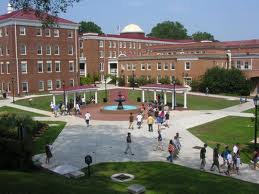 One major indicator seen nationwide are state budget cuts causing a rise in tuition and other fees forcing students to seek more financial aid and, in turn, having more debt after graduation. In addition, programs are cut and limited faculty are available to teach.
One major indicator seen nationwide are state budget cuts causing a rise in tuition and other fees forcing students to seek more financial aid and, in turn, having more debt after graduation. In addition, programs are cut and limited faculty are available to teach.President Barack Obama’s goal for America to have the highest number of college graduates in the world by 2020 took a slight dive after a recent report shows enrollment decreased last year.
According to a preliminary data report from the Department of Education’s National Center for Education Statistics, enrollment throughout the nation’s colleges and universities in fall 2011 slightly decreased from fall 2010 by 34,120 students, or 0.20 percent.
This month’s data focused on more than 21 million students at 7,200 schools that receive federal financial aid. The NCES report did not specify why enrollment decreased by nearly 3 percent at for-profit schools and 0.30 percent at public colleges and universities.
It is the first enrollment reduction since the mid-1990s.
One major indicator seen nationwide are state budget cuts causing a rise in tuition and other fees forcing students to seek more financial aid and, in turn, having more debt after graduation. In addition, programs are cut and limited faculty are available to teach.
However, enrollment at private nonprofit schools slightly increased by nearly 2 percent.
“While the data brought positive news, there was no popping of champagne bottles,” said David Warren, president of the National Association of Independent Colleges and Universities, in an email to Diverse on Monday. “Since the economic downturn, private colleges have boosted student aid and slowed tuition increases, while maintaining the educational quality and personal touch that have long been their hallmarks.”
At Pomona College in Claremont, Calif., student enrollment last fall remained steady with a minimal increase of 20 to 1,563. The tuition rose by almost 4 percent at $39,572. This fall, enrollment increased by 16 students to 1,579, and tuition rose to $41,120, nearly the same percentage as last year.
Karen Sisson, vice president and treasurer at Pomona, said about 58 percent of the students use some form of financial aid. She concedes that the tuition is expensive, but says the benefits are worth the investment.
Sisson said the liberal arts school offers a student-teacher ratio of about 8 to1; students can develop professional and personal relationships with faculty who live on campus; at least 30 percent of the student body is a person of color; and the “great weather” in Southern California.
“There is a more interactive experience here at Pomona with a low student-to-faculty ratio allowing students to think critically, versus a professor who has to teach 45 to 50 students,” said Sisson, who graduated from Pomona in 1979. “I still keep in touch with my professors. … Education is the one investment no one can take from you.”
The NCES data from fall 2010 and fall 2011 highlight enrollment by student level, graduation rates, finances and race/ethnicity.
Although there are only 414,000 students who registered with two or more races, that group has the biggest increase at 24 percent from 312,000 students in fall 2010.
The next highest percent among ethnic groups were Latino students at 6 percent from 2.6 million to 2.8 million; Native Hawaiian students at 5 percent from nearly 61,000 to 64,000; and Asian American students at 1 percent from 1.13 million to 1.15 million.
Blacks remain the largest ethnic group enrolled in colleges and universities with a modest increase at 2 percent from 2.9 million to 2.96 million.
The only ethnic group with a percentage decrease of nearly 5 percent was American Indians from 189,000 to 180,800.
The number of White students enrolled last year is more than all five ethnic groups combined at 11.7 million. However, there was a 1 percent enrollment decrease of those students last fall. Student enrollment at two-year institutions such as community colleges and trade schools slipped by 2 percent from 7.8 million to 7.6 million.
NCES has historical enrollment graphs and figures from selected years dating back to 1947. One table shows how more men attended college than women for 32 straight years.
That changed in 1979 when women exceeded men in college nationwide by 204,000, according to a NCES chart. That same year a final policy interpretation was completed on “Title IX and Intercollegiate Athletics” to ensure equal opportunity for women to compete in college sports.
Last year, more than 3 million women were enrolled in college versus men. Not only have colleges seen a boost in female enrollment, so did tuition and fees. NCES financial data showed those figures at four-year schools increased last year by 11 percent at for-profit schools; 8 percent at public schools; and 6 percent at private schools.
Tuition rose by 32 percent last year for students who attended two-year private schools, but those are only six-figures compared to the millions of dollars at for-profit and public schools. The tuition and fees jumped 10 percent at for-profit schools and 3 percent at public schools.
A final version of the report is scheduled to be released in three months.
For more information and to read the preliminary document, go to http://nces.ed.gov/pubs2012/2012174.pdf.



















